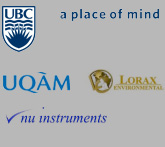 June Cho
June Cho
MSc student
University of British Columbia
Mafic layered intrusions have served as a testing ground for our understanding of key petrologic paradigms for almost a century. Some of these intrusions are also precious and base metal repositories, and their economic significance make them an important resource for both the scientific (ore-forming processes) and industrial (high-value commodities) communities.
I first started working on layered intrusions after I completed my BSc degree in Geological Sciences at UBC. I received an NSERC undergraduate student research award with Drs. Weis and Scoates at PCIGR for the summer. My project involved the detailed identification and characterization of symplectites (reactive microstructures that develop during the last stages of crystallization) in the Kiglapait layered intrusion (Labrador, Canada), using petrographic observations and major/minor element geochemistry to tease out the late-stage processes required to form these enigmatic microstructures.
With my curiosity in magmatic systems piqued, I started an MSc project with the same advisors, studying mafic cumulates of the Skaergaard intrusion (Greenland). The Skaergaard intrusion is a name familiar with most students who have taken an igneous petrology course, and for good reason… it is a spectacularly preserved and well-exposed intrusion that formed from a single pulse of magma and cooled as a closed system. The Skaergaard intrusion is overlain by the vast East Greenland Flood Basalts (~65,000 km2), and there is still debate concerning the genetic links between the Skaergaard and the basalts; in particular: can the Skaergaard be matched with certainty to a particular horizon in these basalts? My MSc project aims to resolve this question using lead isotope compositions of plagioclase from the Skaergaard intrusion obtained by split stream laser ablation ICP-MS, a newly set-up method at PCIGR.
Participating in MAGNET as first, an undergraduate trainee, and now, a graduate trainee, has provided a wealth of experiences and opportunities. MAGNET has been incredible in allowing us to gain a better understanding of the applications of geochemistry in a variety of industrial and academic contexts, to develop our teaching skills in unique, outdoor classroom settings, and to connect us with a diverse group of geochemists from across Canada. I will definitely take what I’ve gained from this wonderful program onto my next geochemistry adventure!
Last updated May 2018


 Catherine Armstrong
Catherine Armstrong Laura Bilenker
Laura Bilenker Priyanka Chandan
Priyanka Chandan Carol Cheyne
Carol Cheyne June Cho
June Cho Sarina Cotroneo
Sarina Cotroneo Jamie Cutts
Jamie Cutts Fiona D'Arcy
Fiona D'Arcy Ashley Davidson
Ashley Davidson Nicolas Estrade
Nicolas Estrade Anaïs Fourny
Anaïs Fourny Evelyn Frères
Evelyn Frères Elizabeth King
Elizabeth King Alexander Lemieux
Alexander Lemieux Miling Li
Miling Li Marc-Antoine Longpré
Marc-Antoine Longpré Gregor Lucic
Gregor Lucic Kalina Malowany
Kalina Malowany Eduardo Mansur
Eduardo Mansur Jill McDermott
Jill McDermott Rhy McMillan
Rhy McMillan Aleksandra Mloszewska
Aleksandra Mloszewska Nichole Moerhuis
Nichole Moerhuis Emily Mullen
Emily Mullen Genna Patton
Genna Patton Jean-David Pelletier
Jean-David Pelletier Elizabeth Phillips
Elizabeth Phillips Nabila Rahman
Nabila Rahman Lindsay Reynolds
Lindsay Reynolds Luiz Felipe Salim Amaral
Luiz Felipe Salim Amaral Cheyenne Sica
Cheyenne Sica Elliott Skierszkan
Elliott Skierszkan Kate Smith
Kate Smith Natalie Szponar
Natalie Szponar Victoria Tweedie
Victoria Tweedie Tom Ver Hoeve
Tom Ver Hoeve Clara Waelkens
Clara Waelkens Nicole Williamson
Nicole Williamson Anne Wozney
Anne Wozney Wang Zheng
Wang Zheng


 Site by Sprout Creative
Site by Sprout Creative